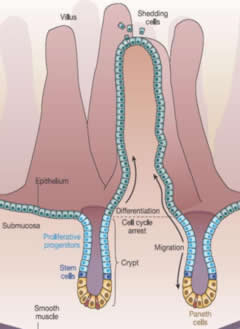Reovirus
naturally infects the lining of the lungs and the bowels
of humans from time to time. For example, the small intestine
is a natural place for reovirus to survive and proliferate
as new cells are constantly being regenerated and shed.
 |
Reovirus
naturally grows in ... "the lining
of the lungs and the bowel where the
cells are bathed in EGF and they are
in sort of a pseudo state of Ras activation.
The reason these isn't a pathology
associated with that is that those
cells die, they self-destruct within
24-36 hours after division anyway and
so it is about the same time that the
virus will actually kill the cell population.
It's the natural reservoir for these
viruses" - Dr. Brad Thompson,
April 2005.
Putative
stem cells (dark blue) reside immediately
above the Paneth cells (yellow) near
the crypt bottom. Proliferating progenitor
cells occupy the remainder of the
crypt. Differentiated cells (green)
populate the villus, and include
goblet cells, enterocytes and entero-endocrine
cells.
Source
of picture: Wnt signalling in stem
cells and cancer - Tannishtha Reya
and Hans Clevers
|
Reovirus
depends on the cells it infects to produce the proteins
it needs to make more copies of itself.
Reovirus does not command the nucleus of
the host cell to produce its mRNA as many other viruses
do, but produces its
own mRNA from the reovirus core. A thick
cloud called a viral factory forms inside the cell where
the proteins are assembled
back into reovirus particles.

Source of Picture: Parker
Lab
Cells have natural defenses against
reovirus.
- Some cells that are penetrated
by a reovirus particle react by killing themselves
off by entering an apoptotic state and are
devoured by the immune system.
- Some
immune cells simply kill the virus and
use it as a marker to kill other cells
that display the same markers (dendritic
cells).
- Other
immune cells create small antibodies to
the virus that attach to the virus
outer proteins and mark it for distruction
even before the virus enters a cell.
- Most normal cells will
automatically prevent the mRNA from generating
more reovirus particles because of a molecule
called PKR circulating within the cell.
Cells in certain unusual states (as cancerous
cells often are) appear to be especially poor at stopping
the reovirus from replicating. In fact, in many cancerous
cells, reovirus is able to replicate and produce 1000's of
prodigy virus out of that one cell before exploding out of
the cell in a process called cell lysis.
|